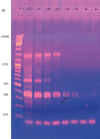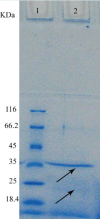Isolation and Characterization of a New Thermoalkalophilic Lipase from Soil Bacteria
- PMID: 26330879
- PMCID: PMC4518119
Isolation and Characterization of a New Thermoalkalophilic Lipase from Soil Bacteria
Abstract
Lipases are diversified enzymes in their properties and substrate specificity, which make them attractive tools for various industrial applications. In this study, an alkalinethermostable lipase producing bacteria were isolated from soil of different regions of Isfahan province (Iran) and its lipase was purified by ammonium sulfate precipitation and ion exchange chromatography. To select a thermoalkalophil lipase producing bacterium, Rhodamine B and Horikoshi media were used and the strain that can grow at 45° Cwas selected. The isolated strain was identified using microbial and biochemical tests. One strain showed an orange colored zone on plate and grew on Horikoshi plate. Microbial and biochemical tests showed that the isolated strain was Bacillus subtilis, a Gram positive rod. In PCR, an expected band was obtained with about 371 bp. The activity of the purified lipase was 10.2 folds that of the standard enzyme using ammonium sulfate precipitation and ion exchange chromatography. The molecular weight of lipase determined by SDS-PAGE electrophoresis, was 21 and 35 KDa. Existence of two bands in SDS-PAGE electrophoresis and low amount of obtained purified enzyme highlights the necessity of optimization of purification and concentrating process.
Keywords: Bacillus subtilis; Lipase; Soil; Thermoalkalophile.
Figures



Similar articles
-
Purification and characterization of extracellular lipase from a thermotolerant strain: Bacillus subtilis TTP-06.3 Biotech. 2023 Oct;13(10):343. doi: 10.1007/s13205-023-03717-6. Epub 2023 Sep 12. 3 Biotech. 2023. PMID: 37711229 Free PMC article.
-
Purification and characterization of an extracellular lipase from Mucor hiemalis f. corticola isolated from soil.J Biosci Bioeng. 2012 Oct;114(4):385-90. doi: 10.1016/j.jbiosc.2012.04.023. Epub 2012 May 30. J Biosci Bioeng. 2012. PMID: 22652088
-
Purification of lipase from Aspergillus fumigatus using Octyl Sepharose column chromatography and its characterization.J Basic Microbiol. 2018 Oct;58(10):857-866. doi: 10.1002/jobm.201800129. Epub 2018 Jul 24. J Basic Microbiol. 2018. PMID: 30039877
-
Production of extracellular lipase from psychrotrophic bacterium Oceanisphaera sp. RSAP17 isolated from arctic soil.Antonie Van Leeuwenhoek. 2021 Dec;114(12):2175-2188. doi: 10.1007/s10482-021-01671-y. Epub 2021 Oct 19. Antonie Van Leeuwenhoek. 2021. PMID: 34665377
-
Isolation and characterization of a thermophilic lipase from bacillus thermoleovorans ID-1.FEMS Microbiol Lett. 1999 Oct 15;179(2):393-400. doi: 10.1111/j.1574-6968.1999.tb08754.x. FEMS Microbiol Lett. 1999. PMID: 10518742
Cited by
-
Enhanced Production and Characterization of a Highly Stable Extracellular Protease from an Extreme Halophilic Isolate Salicola marasensis.Iran J Pharm Res. 2018 Fall;17(4):1392-1412. Iran J Pharm Res. 2018. PMID: 30568698 Free PMC article.
-
DIVERISTY and enzymatic potential of indigenous bacteria from unexplored contaminted soils in Faisalabad.Heliyon. 2023 Apr 7;9(4):e15256. doi: 10.1016/j.heliyon.2023.e15256. eCollection 2023 Apr. Heliyon. 2023. PMID: 37095930 Free PMC article.
-
Realm of Thermoalkaline Lipases in Bioprocess Commodities.J Lipids. 2018 Feb 14;2018:5659683. doi: 10.1155/2018/5659683. eCollection 2018. J Lipids. 2018. PMID: 29666707 Free PMC article. Review.
-
Fungal Screening on Olive Oil for Extracellular Triacylglycerol Lipases: Selection of a Trichoderma harzianum Strain and Genome Wide Search for the Genes.Genes (Basel). 2018 Jan 25;9(2):62. doi: 10.3390/genes9020062. Genes (Basel). 2018. PMID: 29370083 Free PMC article.
-
Microbial lipases: advances in production, purification, biochemical characterization, and multifaceted applications in industry and medicine.Microb Cell Fact. 2025 Feb 12;24(1):40. doi: 10.1186/s12934-025-02664-6. Microb Cell Fact. 2025. PMID: 39939876 Free PMC article. Review.
References
-
- Martinez A, Soberon-Chavez G. Characterization of the lipA gene encoding the major lipase from Pseudomonas aeruginosa strain IGB83. Appl. Microbiol. Biotechnol. 2001;56:731–735. - PubMed
-
- Saranya P, Kumari HS, Rao BP, Sekaran G. Lipase production from a novel thermo-tolerant and extreme acidophile Bacillus pumilus using palm oil as the substrate and treatment of palm oil-containing wastewater. Envir. Sci. Poll. Res. 2014;21:3907–3919. - PubMed
-
- Eggert T, Pencreac'h G, Douchet I, Verger R, Jaeger KE. A novel extracellular esterase from Bacillus subtilis and its conversion to a monoacylglycerol hydrolase. Eur. J. Biochem. 2000;267:6459–6469. - PubMed
-
- Treichel H, de Oliveira D, Mazutti MA, Di Luccio M, Oliveira JV. A review on microbial lipases production. Food Bioprocess Tech. 2010;3:182–196.
-
- Balan A, Magalinggam N, Ibrahim D, Rahim RA. Thermostable lipase production by Geobacillus thermodenitrificans in a 5-L stirred-tank bioreactor. Int. J. Microbiol. 2010;8:2–9.
LinkOut - more resources
Full Text Sources
